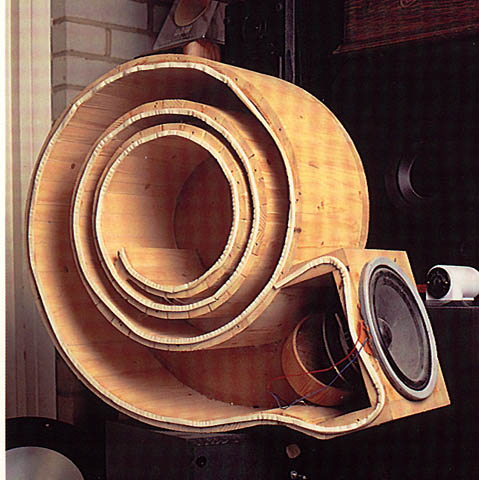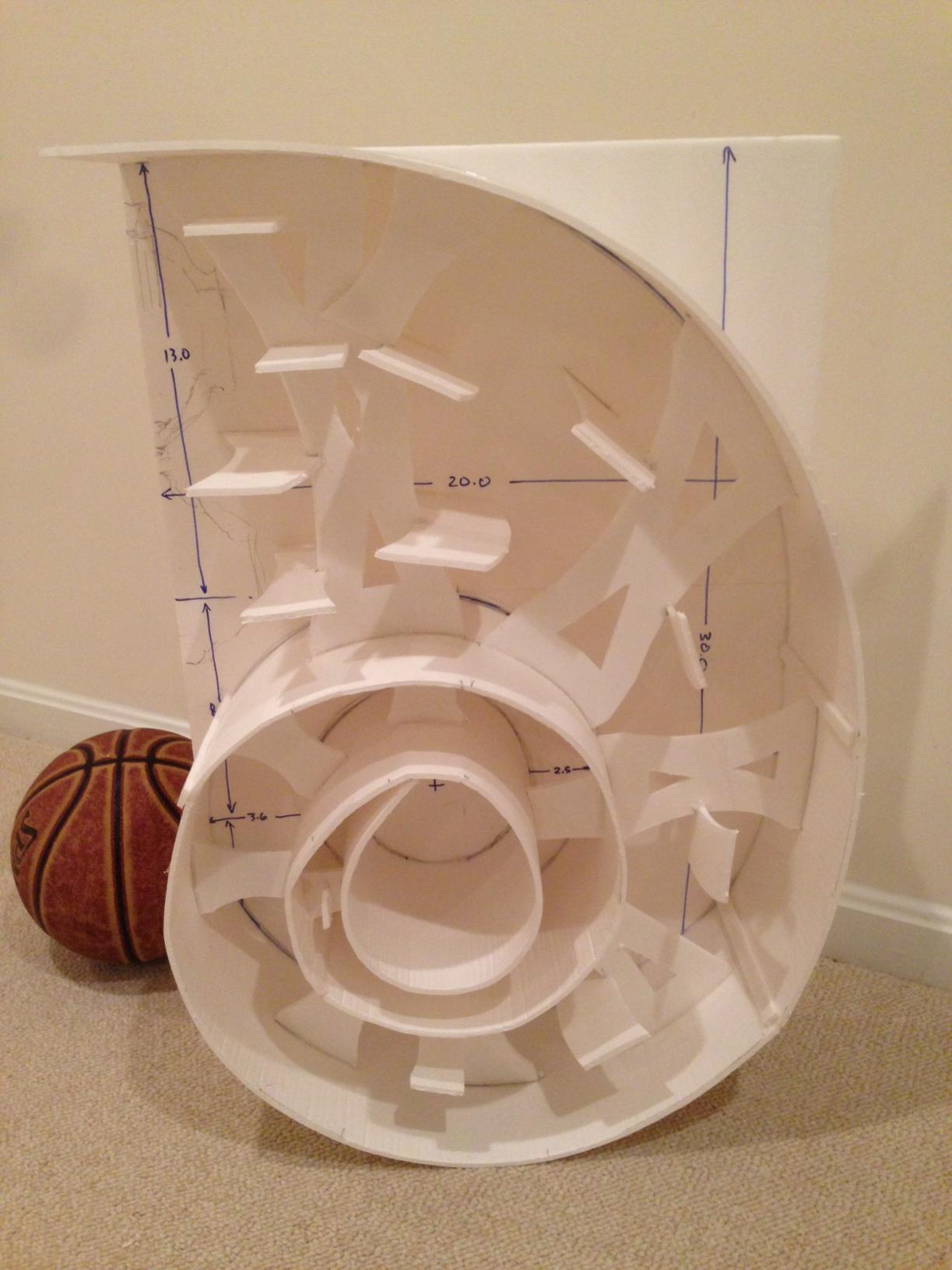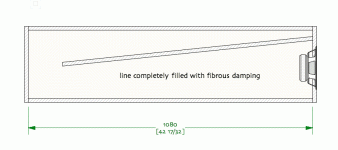I'm intrigued by what I believe is called terminated transmission line...I mean a transmission line inside a sealed enclosure, to be used for the midbass within an active 4-way system.
A couple of sealed subwoofers take care below 80hz. The midabass would cover 80 to 450Hz or so, in a sealed enclosure. Midrange and tweeter would be in sealed boxes too, I think.
Is the midbass a good range for TL? I understand the back wave of the driver bounces back against the back of the cabinet (assuming a flat, vertical surface) and out through the cone itself, out of phase. This generates distortion and is most prominent at frequencies where 1/4 of the wavelength equates the depth of the cabinet. At 80Hz the 1/4 wave is 108cm long, at 150Hz it's 57cm, and at 300Hz it's 29cm. So in my mind midbass is where TL ought to be applied. Am I right?
Are the gains worth the trouble of building this? Maybe I'm conceptually correct but this is not material enough?
Alternatively I could build a quadratic residue diffuser against the back wall to break down the back wave, or even simply place a very large chamfered piece to scatter it.
FWIW, some midbass woofer alternatives under consideration are twin Beyma 10G40 per side (each in its own enclosure), or one 12P80Fe or Nd per side.
Looking forward to your input!
A couple of sealed subwoofers take care below 80hz. The midabass would cover 80 to 450Hz or so, in a sealed enclosure. Midrange and tweeter would be in sealed boxes too, I think.
Is the midbass a good range for TL? I understand the back wave of the driver bounces back against the back of the cabinet (assuming a flat, vertical surface) and out through the cone itself, out of phase. This generates distortion and is most prominent at frequencies where 1/4 of the wavelength equates the depth of the cabinet. At 80Hz the 1/4 wave is 108cm long, at 150Hz it's 57cm, and at 300Hz it's 29cm. So in my mind midbass is where TL ought to be applied. Am I right?
Are the gains worth the trouble of building this? Maybe I'm conceptually correct but this is not material enough?
Alternatively I could build a quadratic residue diffuser against the back wall to break down the back wave, or even simply place a very large chamfered piece to scatter it.
FWIW, some midbass woofer alternatives under consideration are twin Beyma 10G40 per side (each in its own enclosure), or one 12P80Fe or Nd per side.
Looking forward to your input!
A sealed TL is a half-wave resonator. The idea is that with the radiation going thru all the damping to the end of the line and back it is pretty much all absorbed before it gets back to the driver. 1/2 wave at 80hz (by your calc) is 215 cm. If you are XOing that low you really would like to go lower.
The leading example of such a speaker is the 4-way Nautilus.

dave
The leading example of such a speaker is the 4-way Nautilus.

dave
X's example is a good one, but foam-core (in most cases) for more than a proto-type probably won't cut the mustard… for more ideas here is the B&W prototype for the bass section of the Nautilus i posted:

dave

dave
hi Planet10 - can a rectangular box t-line with flat internal panels approach this level of performance or are the discontinuities and reflections too much?
FWIW, some midbass woofer alternatives under consideration are twin Beyma 10G40 per side (each in its own enclosure), or one 12P80Fe or Nd per side
You want a forward/ frontal radiation/emission
only subwoofers, i.e. below 50/80 Hz that have omnidirectional properties due to the very long wave lenght can be placed where you can't see them.
I assume the driver can move "90 degrees" so the structure can stand upright
Yes.
dave
A sealed TL is a half-wave resonator. The idea is that with the radiation going thru all the damping to the end of the line and back it is pretty much all absorbed before it gets back to the driver. 1/2 wave at 80hz (by your calc) is 215 cm. If you are XOing that low you really would like to go lower.
The leading example of such a speaker is the 4-way Nautilus.

dave
Yes, I was aware of the Nautilus. I've come across some posts saying it looks better than it sounds, so wondering it it's worth the effort.
So I should look at 1/2 wave length instead of 1/4 wave. What did you mean by this, though?
How long do I need to make the line for 80Hz crossover?If you are XOing that low you really would like to go lower.
For now:

Dimensioned for length, other dimensions to give proper sealed volume Q, 10:1 line should give some more extension to enable 80Hz XO.
dave
This looks closer to what I had in mind. Help me with the math: 1080mm long is about a full wavelength at 320Hz, or 1/2 wave at 160Hz, or 1/4 wave at 80Hz. What is the frequency range this box is designed for?
With enough stuffing in tapered tail it absorbs back wave well so you won't really get back reflection. The half wave corresponds to frequency using speed of sound to get point of first back wave reflection.
So I should look at 1/2 wave length instead of 1/4 wave. What did you mean by this, though?
A sealed box is always a 1/2 wave line, if you put an open terminus in it, it becomes a 1/4 wave line.
For 80 Hz, the line i drew is probably sufficient. The heavy taper lowers the primary resonance of the line.
dave
This looks closer to what I had in mind. Help me with the math: 1080mm long is about a full wavelength at 320Hz, or 1/2 wave at 160Hz, or 1/4 wave at 80Hz. What is the frequency range this box is designed for?
The 2.16 m length is based on your earlier statement that 1/4 wave length at 80 Hz is 108 cm. So for half wave it needs to be 2x as long, which is what the fold does. I did not check your math.
dave
Yes, I was aware of the Nautilus. I've come across some posts saying it looks better than it sounds, so wondering it it's worth the effort.
So I should look at 1/2 wave length instead of 1/4 wave. What did you mean by this, though?
How long do I need to make the line for 80Hz crossover?
Any perceived performance shortcomings has nothing to do with its driver loading, which SQ-wise is theoretically as good as it gets for a given net bulk.
As Dave noted, open [and tapered] pipes are 1/2 WL resonators, so Fp = SoS/2/pipe length is the acoustic tuning and then there's an end correction calculated based on the terminus area [Av or Sm] + any boundary loading [4, 2, 1 or 0.5 pi] conditions is subtracted to make its physical [cut] length shorter in reality, so the larger the Av and the greater the boundary area the shorter it will be.
The Nautilus though is closed at both ends, so its cut length = acoustic length like a plane wave tube [PWT], ergo can be stuffed all along its length or damped just at the end opposite the driver: Resonances of open air columns
GM
The idea of acoustically terminated transmission lines is nice in theory, but getting it to work in practice isn't trivial. You could probably get it to sound good, but I doubt it will be considerably better than a well-damped conventional closed box. You should google "acoustic impedance tube" for some theory.
By the way, what is commonly called a transmission-line loudspeaker, in my book really isn't. It's a badly terminated transmission-line at best, which I'd rather call a tuned resonator. In that sense it is actually similar to a bass-reflex loudspeaker.
By the way, what is commonly called a transmission-line loudspeaker, in my book really isn't. It's a badly terminated transmission-line at best, which I'd rather call a tuned resonator. In that sense it is actually similar to a bass-reflex loudspeaker.
The idea of acoustically terminated transmission lines is nice in theory, but getting it to work in practice isn't trivial. You could probably get it to sound good, but I doubt it will be considerably better than a well-damped conventional closed box. You should google "acoustic impedance tube" for some theory.
By the way, what is commonly called a transmission-line loudspeaker, in my book really isn't. It's a badly terminated transmission-line at best, which I'd rather call a tuned resonator. In that sense it is actually similar to a bass-reflex loudspeaker.
It's not that hard to get it to work well. I have used the Nautaloss with over 20 different drivers ranging from 2.5in to 5in and they all measure smoothly with no coloration or boxy sound. I stuff mine with polyfill the whole length. Measurements and sound clips are in the Subjective Blind Test tests. In my mind, it is about one of the most forgiving and easiest enclosures to work for mid bass and up. It measures like an open back infinite baffle.
Round 1:
http://www.diyaudio.com/forums/full...nd-comparison-3in-5in-full-range-drivers.html
Round 2:
http://www.diyaudio.com/forums/full...ind-comparison-3in-5in-drivers-round-2-a.html
- Home
- Loudspeakers
- Multi-Way
- Terminated transmission line for midbass?

